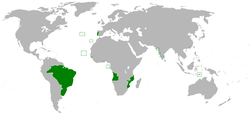Kingdom of Portugal
You can help expand this article with text translated from the corresponding article in Portuguese. (January 2012) Click [show] for important translation instructions.
|
Kingdom of Portugal and the Algarves [Reino de Portugal e dos Algarves] Error: {{Lang}}: text has italic markup (help) Template:Pt icon [Regnum Portugalliae et Algarbia] Error: {{Lang}}: text has italic markup (help) Template:La icon | |||||||||||
|---|---|---|---|---|---|---|---|---|---|---|---|
| 1139–1910 | |||||||||||
| Motto: Vis Unita Maior Nunc et Semper "The united force now and always" | |||||||||||
| Anthem: O Hino da Carta "Anthem of Charter" | |||||||||||
 The Kingdom and its dominions in 1800. | |||||||||||
| Capital | Coimbra (1139–1255) Lisbon[1] (1255–1910) | ||||||||||
| Common languages | Portuguese | ||||||||||
| Religion | Roman Catholic | ||||||||||
| Government | Absolute Monarchy (1139–1822 / 1823-1826 / 1828–1834) Constitutional Monarchy (1822–1823 / 1826-1828 / 1834–1910) | ||||||||||
| Monarch | |||||||||||
• 1139–1185 | Afonso I (first) | ||||||||||
• 1908–1910 | Manuel II (last) | ||||||||||
| Prime Minister | |||||||||||
• 1834–1835 | Pedro de Holstein (first) | ||||||||||
• 1910 | António Teixeira (last) | ||||||||||
| Legislature | Cortes | ||||||||||
• Upper house | Chamber of Peers | ||||||||||
• Lower house | Chamber of Deputies | ||||||||||
| History | |||||||||||
• Established | 26 July 1139 | ||||||||||
| 1808–1814 | |||||||||||
| 16 December 1815 | |||||||||||
| 29 August 1825 | |||||||||||
| 1 February 1908 | |||||||||||
| 5 October 1910 | |||||||||||
| Currency | Portuguese dinheiro, (1139–1433) Portuguese real (1433–1910) | ||||||||||
| ISO 3166 code | PT | ||||||||||
| |||||||||||
1. ^ The capital was located at Rio de Janeiro from 1808 to 1821. | |||||||||||
The Kingdom of Portugal (Portuguese: Reino de Portugal, Latin: Regnum Portugalliae), or the Kingdom of Portugal and the Algarves (Portuguese: Reino de Portugal e dos Algarves,[1][2][3][4] Latin: Regnum Portugalliae et Algarbia), was Portugal's general designation under the monarchy. The kingdom was located in the west of the Iberian Peninsula, Europe and existed from 1139 to 1910. It was replaced by the Portuguese First Republic after the 5 October 1910 revolution.
History
Origins
The Kingdom of Portugal finds its origins in the County of Portugal (1093–1139). The Portuguese County was a semi-autonomous county of the Kingdom of Leon. Independence from Leon took place in three stages:
- The first on July 26, 1139 when Afonso Henriques was acclaimed King of the Portuguese[5] internally.
- The second was on October 5 of 1143, when the Kingdom of Leon and the Kingdom of Castile recognized Afonso Henriques as king through the Treaty of Zamora.
- The third, on 1179, was the Papal Bull Manifestis Probatum, in which Portugal's independence was recognized by the Pope.
Once Portugal was independent, D. Afonso I's descendants, members of the Portuguese House of Burgundy, would rule Portugal until 1383. Even after the change in royal houses, all the monarchs of Portugal were descended from Afonso I, one way or another, through both legitimate and illegitimate links.
Fall of the Monarchy
With the turn of the 19th to 20th century, republicanism would grow in numbers and support in Lisbon among progressive politicians and the influential press. However a minority with regard to the rest of the country, this height of republicanism would benefit politically from the Lisbon Regicide on February 1, 1908. When returning from the Ducal Palace at Vila Viçosa, King Carlos I and the Prince Royal Luis Filipe were killed in the Terreiro do Paço, in Lisbon. With the death of the king and his heir, Carlos I's second son would become king as King Manuel II of Portugal. Manuel's reign, however, would be short-lived, ending by force with the 5 October 1910 revolution, sending Manuel into exile in England and giving way to the Portuguese First Republic.
The Portuguese Empire

Over time, the Kingdom of Portugal built what was known as the Portuguese Empire. Starting with the Conquest of Ceuta in 1415, the empire expanded with the addition of many colonies, the largest of which was Brazil (established in 1500 and dissolved in 1822). After the republican revolution in 1910, the remaining colonies of the empire became overseas provinces of the Portuguese Republic until the late 20th century, when the last overseas territories of Portugal were handed over (most notably Portuguese Africa, which included the overseas provinces of Angola and Mozambique, in 1975, and finally Macau in 1999).
After centuries of Portuguese dominion in Angola, the Kingdom of Kongo was made a vassal state of the Portuguese Kingdom, its king pledging alliegance to the King of Portugal.
Rulers
Notes
Sources
- Joaquim Veríssimo Serrão, História de Portugal: Do mindelo á regeneração (1832-1851)
- José Mattoso, António Manuel Hespanha, História de Portugal 4: O Antigo Regime (1620-1807), (1998) ISBN 972-33-1311-1
- Simão José da Luz Soriano, Historia da Guerra Civil e do estabelecimento do governo parlamentar em Portugal: comprehedendo a historia diplomatica, militar e politica d'este reino desde 1777 até 1834 Volume 9 (1893)
- Jacinto de São Miguel (Frei), Martinho Augusto Ferreira da Fonseca, Mosteiro de Belém: Relação da insigne e real casa de Santa Maria de Belém (1901)
- Mark Willner, George Hero, Jerry Weiner, Global History Volume I: The Ancient World to the Age of Revolution (2006) ISBN 978-0-7641-5811-7
- Douglas L. Wheeler, Republican Portugal: A Political History, 1910-1926 (1998) ISBN 978-0-299-07454-8




